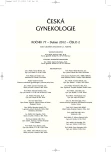Effect of GnRH analogues pre-treatment on myomectomy outcomes in reproductive age women
Authors:
R. Hudeček; Z. Ivanová; M. Šmerdová; S. Pánková; R. Krajčovičová
Authors‘ workplace:
Gynekologicko-porodnická klinika LF MU a FN Brno, přednosta prof. MUDr. P. Ventruba, DrSc., MBA
Published in:
Ceska Gynekol 2012; 77(2): 109-117
Category:
Original Article
Overview
Objective:
To evaluate the role of three-monthly pre-treatment with gonadothropin releasing hormone (GnRH) analogues prior to myomectomy for women in comparison with control group of patients with no application. Analysis is focused on peroperative and postoperative results of surgery treatment for women with clinically symptomatic uterine fibroids in reproductive age with interest in getting pregnant.
Design:
Prospective clinical study.
Setting:
Gynecological and Obstetric Clinic of Medical Faculty of Masaryk University and the University Hospital Brno.
Main measures:
The group of 212 patients with symptomatic uterine fibroids detected by ultrasound. 90 patients (42.5%) underwent laparoscopic myomectomy (LM) and 122 patients (57.5%) underwent open laparotomic myomectomy (OM). In the selected group we were observing the common number of exstirpated uterine fibroids, their size, anatomical localisation, depth of invasion of dominant exstirpated uterine fibroid in relation to uterine wall.
Methods:
Both groups of patients were randomised into two parts. The group LM with GnRH pre-treatment contained 42 patients (19,8 %) and control group with no pre-treatment 48 patients (22.7%). Laparotomic part of study was divided into two groups with preoperative application of GnRH analogues 44 patients (36,7 %) and control group OM with no application 44 patients (20.8%). The main outcome measures were peroperative blood loss, duration of surgery, the length of hospital stay, evidence of per- and postoperative complications and the final results by second look laparoscopy (SLL).
Results:
In the observed group LM with pre-treatment of GnRh analogues there was significantly higher volume of blood loss (p = 0.0003), significantly longer duration of surgery (p = 0.0063) and significantly higher lenght of hospital stay (p = 0.0025) compared with control group. We have not found a significant difference in the incidence of peroperational converse to laparotomy, final result of neoformation of uterus wall and occurrence of postoperative adhesions by SLL in observed LM group compared with control group. In the observed OM group with pre-treatment of GnRH analogues there was no significant difference in: peroperative blood loss (p = 0.5324), duration of surgery (p = 0.3927) neither average length of hospital stay compared with control group. In the OM group, there was significantly lower incidence of recidives of uterine fibroids observed by SLL (p = 0.0025) and no significant difference of occurrence of postoperative adhesions compared with control group. We have not found significant difference in the incidence of peroperative complications, early and late postoperative complications in group of LM and OM in comparison with control groups.
Conclusion:
Application of GnRH analogues in observed group of patients before LM and OM have not lead to improvement of peroperative results in comparison with control group. Pre-treatment of GnRh analogues before OM have lead to significant drop in recidives of uterine fibroids observed by SLL (p = 0.0025) compared with control group.
Key words:
GnRh analogues, laparoscopic myomectomy, laparotomic myomectomy, peroperative results, postoperative results.
Sources
1. Bajekal, N., Li, TC. Fibroids, infertility and pregnancy wastage. Hum Reprod Update, 2000, 6, p. 614.
2. Bulletti, C., et al. The role of leiomyomas in infertility. J Am Assoc Gynecol Lapar, 1999, 6, p. 44.
3. Citterbart, K., et al. Gynekologie. Praha: Galén, 2001.
4. De Leo, V., Morgante, G., La Marca, A., et al. A benefit-risk assessment of medical treatment for uterine leiomyomas. Drug Staf, 2002, 25, p. 759–779.
5. Dubuisson, JB., et al. Reproductive outcome after laparoscopic myomectomy in infertile women. J Reprod Med, 2000, 45, p. 23.
6. Eldar-Geva, T., et al. Effect of intramural, subserosal, and submucosal uterine fibroids on the outcome of assisted reproductive technology treatment. Fertil Steril, 1998, 70, p. 687.
7. Friedman, AJ., Rein, MS., Harrison-Atlas, D., et al. A randomized, placebo controlled, double blind study evaluating leuprolide acetate depot treatment before myomectomy. Steril Fertil, 1989, 52, p. 728–733.
8. Golan, A. GnRH analogues in the treatment of sterine fibroids. Hum Reprod, 1996, 11(3), p. 33–41.
9. Hart, R., et al. A prospective controlled study of the effect of intramural uterine fibroids on the outcome of assisted conception. Hum Reprods, 2001, 16, p. 2411.
10. Kučera, E., Živný, J. Sterilita při děložním myomu a její ovlivnění operační léčbou. Čes Gynek, 1997, 42, s. 324.
11. Kučera, E., Fait, T., a kol. Hyperestrogenní stavy v gynekologii. Praha: Maxdorf, 2011, s. 121–126.
12. Li, TC., et al. Myomectomy: a retrospective study to examine reproductive performance before and after surgery. Hum Reprod, 1999, 14, p. 1735.
13. Mára, M., Řežábek, K., Živný, J. Děložní myom a poruchy plodnosti. Mod Gynek Porod, 2002, 11, s. 614.
14. Mára, M., Fučíková, Z., Mašata, M., a kol. Management děložních myomů u žen ve fertilním věku. Čes Gynek, 2003, 68, s. 30–35.
15. Mára, M., Holub, Z., a kol. Děložní myomy – moderní diagnostika a léčba. Praha: Grada, 2009.
16. Poncelet, C., et al. Myoma and infertility: analysis of the literature. Gynecol Obstet Fertil, 2001, p. 29–41.
17. Sankaran, S., Manyonda, IT. Medical management of fibroids. Best Pract Res Clin Obstet Gynaecol, 2008, 22, p. 655–676.
18. Smith, DC., Uhlir, JK. Myomectomy as a reproductive procedure. Am J Obstet Gynecol, 1990, 162, p. 1476.
19. Stovall, D., et al. Uterine leiomyoma reduce the efficacity of assisted reproduction cycles: results of a matched follow-up study. Hum Reprod, 1998, 13, p. 192.
20. Zwinger, A. Spontánní a opakovaný potrat. Mod Gynek Porod, 2000, 9, s. 367.
Labels
Paediatric gynaecology Gynaecology and obstetrics Reproduction medicineArticle was published in
Czech Gynaecology

2012 Issue 2
Most read in this issue
- Triple negative breast cancer – prognostically highly unfavourable group cancer of breast
- Possibilities of IVF in native cycle
- Urinary tract infections in pregnancy: when to treat, how to treat, and what to treat with
- Vaginal birth after previous caesarian section – outcomes analysis 2007–2010
